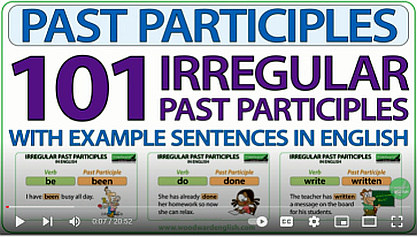The three perfect tenses in English—the present perfect, the past perfect, and the future perfect—capture the idea that one event or occurrence happened or happens before another time or event in the present, past, or future. These tenses are achieved grammatically by using a form of the verb “have” together with the past participle* of the main verb, then using the formula
“Subject + (have/has/had/will have) + past participle” to form the sentence.
The
present perfect tense specifically refers to an event that occurred in an unspecified past time, in which the action has been completed but the time period is not or is of an indefinite duration. We can understand this concept more clearly by looking at the timeline of the present perfect tense shown below:
One unique characteristic of the present perfect is that it cannot be used to refer to a specific past time but only to an unspecified or indefinite one. We therefore cannot construct sentences like these two: “Alberto has taken the train yesterday.” “The country has taken austerity measures last year.” This is because the time frames of both “yesterday” and “last year” are specific and definite and thus fail to satisfy the requirement of the present perfect tense.
The present perfect will work on those two sentences only if “yesterday” and “last year” are taken out to make the sentences read as follows: “Alberto
has taken the train.” “The country
has taken austerity measures.” The sentences are now silent about exactly when Alberto took the train, and exactly when the country took austerity measures. Without such precise information, the present perfect “has taken” is now able to do its work properly in both sentences.
The present perfect works in at least six specifically identifiable ways to define events and occurrences as they unfold in time, thus allowing us to describe these events and occurrences with indefinite subtlety rather than exactitude. The six are as follows:
—To express a state or condition that began in the past and leads up to and including the present: “Monique
has stayed here for months.” “They
have eaten nothing but cereal for weeks.” “The conspirators
have kept their vow of silence for decades.”
—To express habitual or continued action: “He
has worn elevator shoes since fifteen.” “She
has spouted ideological slogans all through college.” “They
have sworn to fight for freedom no matter what the cost.”
—To indicate events occurring at an indefinite time in the past (used in tandem with the adverbs “ever,” “never,” and “before”): “
Has Robert ever been to Manila?” “Some people
have never gone out of their town.” “The young man
admits that he has met that woman before.”
—To indicate that an action happened only recently (used in tandem with the adverb “just”): “Mother
has just finished her cooking.” “We
have just cooked hotdogs.”
—To indicate that an action happened more than once, but it is not important or necessary to know exactly when: “I
have gone to the United States five times.” “She
has told me that story a thousand times.”
—To indicate that something that happened in the past still continues to influence the present: “Eduardo
has thought about getting a new computer every day this week.” “The bad weather
has reduced farm outputs seriously; for which reason the town mayor
has increased farmer subsidies.”
We can see that the present perfect gives us the power to better comprehend the conditions of the moment by marking them in relation to things that took place before, thus intensifying our perception of time as well as the reality of occurrences and events.
As the old saying goes, “To understand the present, you must look back to the past.” The present perfect nicely validates that wisdom.
-------------
*For a clearer idea of the extent of variation from the normative “-ed”
ending of the past participles of irregular verbs, click the link below
to the Woodward English YouTube video presentation of “101 Irregular
Past Participles in English” with examples: https://www.youtube.com/watch?v=iK8-ff8CpIE 
(Next:
Timeline for the past perfect tense) October 21, 2021
This essay, 2066th of the series, appeared in the column “English Plain and Simple” by Jose A. Carillo in the Campus Press section of the October 14, 2021 Internet edition of The Manila Times
,© 2021 by the Manila Times Publishing Corp. All rights reserved.Read this article online in
The Manila Times:
Timeline for the present perfect tense To listen to the audio version of this article, click the encircled double triangle logo in its online posting in
The Manila Times.